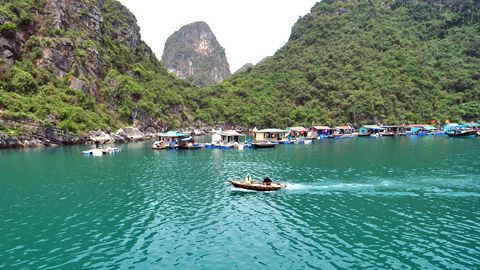If you have a plan to visit Hanoi, the capital of Vietnam, you don't miss some most famous resorts as follow, which are best places for relaxing, and picnicking in Hanoi
1. Asean Resort - Hòa Lạc, Thạch Thất, Hà Nội.
Address: 21A Hoa Lac, Thach That, Hanoi
 Grass Skiing
Grass Skiing
The resort, located about 35km from the center of Hanoi, is quiet cool, lots of trees. For those who want to go no far from Hanoi but require a quiet, clean place, this is the perfect place for tourists in Vietnam tours to choose for weekend trips with friends and family.
While other resorts favored by the flavor of the sea, the resort attracts tourists by the types of natural services such as: hot water pools, Ninh Kieu hot springs, grass skiing, etc.
However, the price of this resort of the highest ones in many resorts around the capital. The plus point is whether the public holiday prices here are not "high" up. On average, every room here from 3.5 million to VND 21 million / night (prices are accompanied by such services as dining, entertainment, spa ...).
2. Van Minh Resort - Chúc Sơn, Chương Mỹ, Hà Nội
Address: Chuc Son town, Chuong My district, Hanoi.
Located at the entrance of the Capital, the National Road No 6 to Hoa Binh and about half hour driving from Ha Noi, Van Minh Resort is a complex resorts, nearby two national sceneries are Tram Pagoda, and Tram Gian Pagoda. This area has 40 rooms overlooking to the countryside and Xu Doai mountains.
The price of Van Minh Resort is from VND960.000 a day or more depending on the type of room and room area.
3. Tan Da Resort - Tản Lĩnh, Ba Vì, Hà Nội
Address: Tan Linh commune, Ba Vi district, Hanoi
Just one hour driving from Hanoi to check in Tan Da Spa Resort where is the perfect location for escaping couple in holidays (2 or 3 nights) or family group at weekend and Meeting, Incentive, Events and Conference groups.
The resort was designed in opening space, peaceful and tranquil-a new envision for the mélange of nature and human beings, a deep feeling of living amidst a blue and cloudy sky of the marvelous Tan Vien mountain-Da River of the legendary story of the God of Mountain and the God of River. It’s main purpose to offer relaxation and refreshing rest.
Tan Da Spa Resort offering 53 rooms designed by the ancient architecture of the country villages typical of Bac Bo countryside (Viet Ancient House) and the houses of “East meets West” (Lac Viet House). Visitors can live and really feel the culture traits of the old Viet people amidst a green and fresh space with green and yellow bamboo clumps, trellises of gourds, water wells…
The interior decorations were simply built with a combination of bamboos and wood…to give the visitors the feeling of escaping from daily pressure of work and of enjoying hours of living in a peaceful atmosphere. However, the rooms are also equipped with modern gadgets such as cable television, fridges, air-conditioners, mini bar, Wifi Internet, Room Service...
And especially relax in the hot an cool mineral water pool in the resort to balance yourself
After a day in the hot mineral water of the nature source and have some special wine and cuisin of the forest, mountain, guest will find a balance self in Tanda Spa Center with various service package to get health better such as Foot masssage, Facial treatment, body massage, Hot stone massage, soaking baths with natural miner water, red wine, champagne, stout, fresh goat milk, fresh cow milk, green tea.
Da Ong Club is where you can relax and enjoy with your group in karaoke, Singer room, Double bikes, tennis, billiards, badminton, electric cars for Vietnam tour, the funny Swan boat, motorboat to relax on the lake and you can do fishing on the lake also.
Room prices are from VND1, 5 million to VND 6.5 million / night depending on room type and room area.
4. Hoang Long Resort - Thạch Thất, Hà Tây
Address: Thach That , Ha Tay district, Hanoi
Situated on an area of 2 square kilometers in Thach That, Ha Tay, about 1km from Tay Phuong Pagoda, Hoang Long Resort is designed elegant, rustic space and is a very peaceful resort.
The strong point of the Hoang Long Resort is eco-tourism area with various services. A further utility of the Hoang Long resort is a play area for kids. If any family with young children, there is a spacious area which named Vuon Co Tich will make the boys and girls enjoy being playful relaxed under the shade of trees and very interesting game, etc.
if tourists in Vietnam travel are a lover of plants, you'd be amazed at the collection and look how many plants throughout the region are gathering in Vietnam Hoang Long Resort.
The prices of Hoang Long’s rooms are in quite reasonable because it is newly built resort but you can be completely assured of quality service.




























